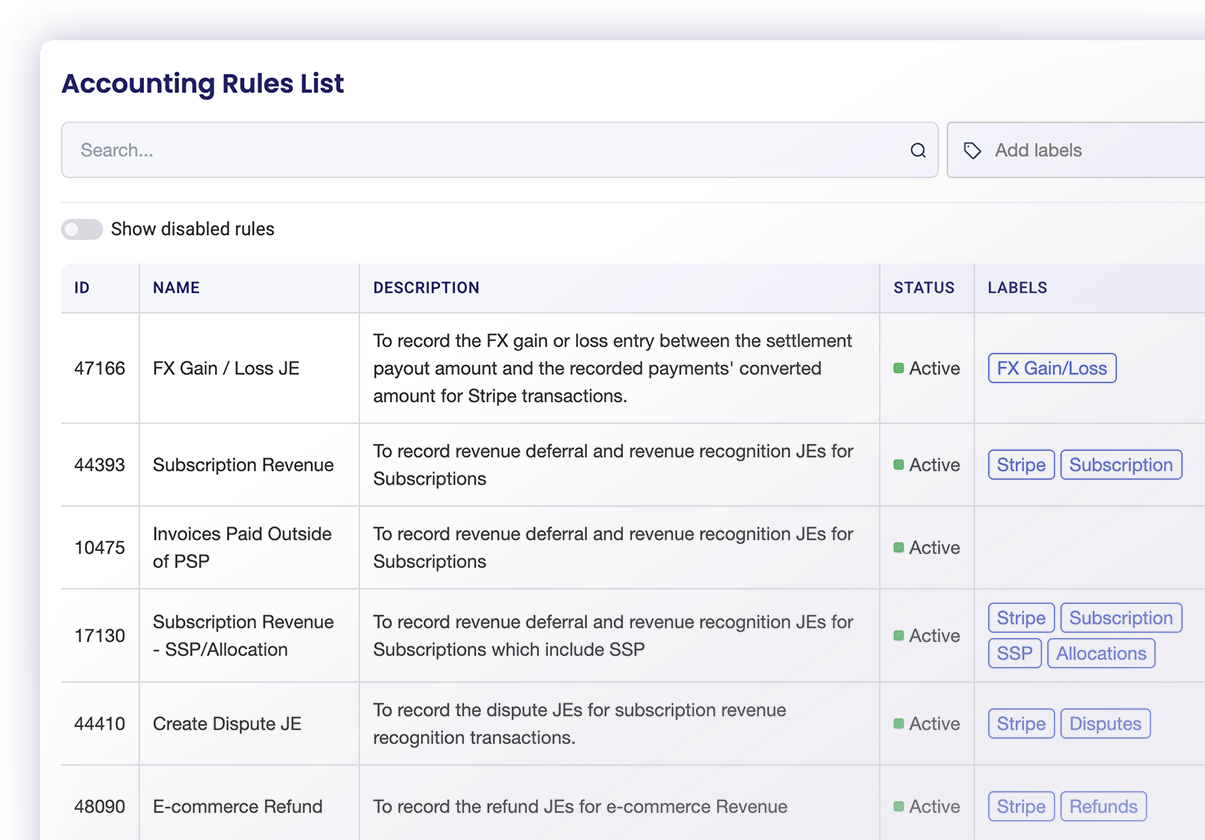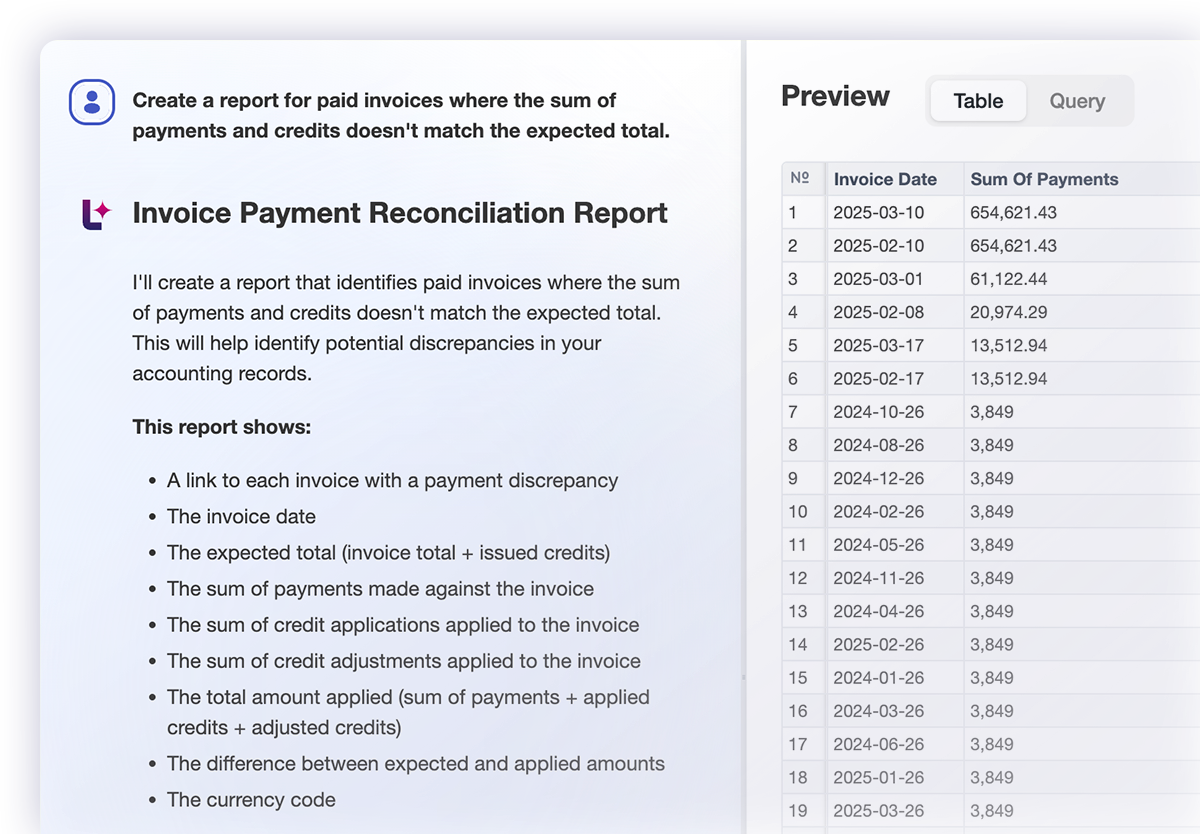Reconcile Stripe usage-based billing transactions
Scale your finance operations with automated revenue reconciliation and recognition that handles the complexity, unpredictability, and large volume of data generated with usage-based billing.

Automatically reconcile Stripe usage-based billing transactions
Usage-based pricing is growing in popularity especially among leading AI companies. The pricing model is very consumer friendly – only paying for what you use – but it adds substantially more complexity to the accounting treatment required in the reconciliation and rev rec process. Built to handle large volumes of transaction data that come with usage-based billing, Leapfin’s accounting automation software automatically reconciles Stripe billing and payments and creates clean journal entries and summaries, complies with industry standards, and gives FP&A teams full visibility into revenue in real-time.
Benefits of integrating Leapfin with Stripe
Automatically transform and enrich raw Stripe data at scale
Reliably account for every transaction by automatically standardizing transactions, establishing links throughout the order-to-cash journey, and applying accounting treatment rules
Fast, accurate revenue recognition powered by finance-grade AI
Overcome pricing complexity with automated rev rec that allows you to easily account for meters, credits, and flexible plans; and make changes as your offerings evolve and your business grows.
Easily explore Stripe data simply by asking
Use natural language prompts with Leapfin’s AI agent, Luca, to drill into detailed Stripe usage data so you can review revenue results, understand data anomalies, and explore performance trends that inform cross-functional business decisions.



Integrate Stripe with Leapfin to gain control of your revenue data
Resources for managing revenue data from Stripe
FAQs
Yes, Leapfin has an extensive native integration with Stripe. Customers rely on Leapfin’s integration to ingest Stripe billing and payment data, to ensure accurate revenue reconciliation and recognition at scale.
Yes, Leapfin can automatically reconcile and recognize revenue upon consumption.
Yes, Leapfin can automatically account for credit issuance liability and accounts receivable.
Yes, Leapfin can automatically account for upfront payment for credits, deferment schedules, and prepayment liability. Revenue can also be automatically recognized upon consumption of credits.
Yes, Leapfin is technology agnostic and can ingest transaction data from any usage-based billing provider including Stripe, Metronome, and Orb.
Yes, the Connected Accounting Map in Leapfin allows users to easily see how all of their Stripe transactions – payment sources, refunds, credits, and disputes – are linked. And users can also see how any of those transaction types are linked to data from other packaged or home-grown solutions.
Stripe transactions are raw data that is organized into columns and formats based on the Stripe implementation. It does not consider the characteristics required to be accounting-ready including journal entry formats, currency conversion, timezones, timeframe (relative to month-end close), etc. Stripe data is always changing and has no way of locking data at the end of the month; Leapfin allows users to lock for month-end close and automatically post adjustments in the next period.
Yes, but unfortunately it can be very limited and difficult to work with. Luca, Leapfin’s native AI agent, enables users to easily explore Stripe data that has already been normalized and transformed into accounting-ready data, making it easier to synthesize and actionable. Luca offers dozens of templated prompts that cover many common questions, along with the ability to write your own original prompts. Results can also be saved as reports for future reference and shared within your organization’s workspace.
Real-world examples of improving operational efficiency with accounting automation
-
 This isn’t just about automation. It’s about giving our team a system we trust, and the time and space to focus on higher-value work. I’m such a fan. I can’t say enough good things about Leapfin. It has been a huge win for us.Alicia Arntson, CPA VP, Controller, Eight Sleep
This isn’t just about automation. It’s about giving our team a system we trust, and the time and space to focus on higher-value work. I’m such a fan. I can’t say enough good things about Leapfin. It has been a huge win for us.Alicia Arntson, CPA VP, Controller, Eight Sleep -
 I finally feel like I can fully support the numbers I’m posting to NetSuite every month. If someone asks, I don’t need to explain assumptions – I just pull the report in Leapfin.Brian Cheung Sr. Manager, Accounting, GoodRx
I finally feel like I can fully support the numbers I’m posting to NetSuite every month. If someone asks, I don’t need to explain assumptions – I just pull the report in Leapfin.Brian Cheung Sr. Manager, Accounting, GoodRx -
 Leapfin is like our digital glue. It connects all of our financial data sources together so our team isn’t spending time manually tying everything out.Rebecca Wang VP Finance Corporate Controller, Guideline
Leapfin is like our digital glue. It connects all of our financial data sources together so our team isn’t spending time manually tying everything out.Rebecca Wang VP Finance Corporate Controller, Guideline -
 With Leapfin, we are faster, we are more accurate, and we are drama-free. It's transformed our close process. No surprises, no last-minute scrambles. Everything just runs smoothly.Rodrigo Brumana CFO, Poshmark
With Leapfin, we are faster, we are more accurate, and we are drama-free. It's transformed our close process. No surprises, no last-minute scrambles. Everything just runs smoothly.Rodrigo Brumana CFO, Poshmark -
 The feed from Leapfin to NetSuite works seamlessly. It's something that we don't have to worry about anymore.Lindsay Remigio Sr. Manager, Revenue Accounting, Reddit
The feed from Leapfin to NetSuite works seamlessly. It's something that we don't have to worry about anymore.Lindsay Remigio Sr. Manager, Revenue Accounting, Reddit -
 The consolidated view of our revenue in Leapfin is fantastic. In literally one click we can easily see change month to month. And, because every single transaction is right there, we can dig into details for any explanation we may need.Melissa Tuttle Director of Accounting Systems, Outside
The consolidated view of our revenue in Leapfin is fantastic. In literally one click we can easily see change month to month. And, because every single transaction is right there, we can dig into details for any explanation we may need.Melissa Tuttle Director of Accounting Systems, Outside -
 Leapfin helped parse out and make sense of the data that already existed. Simple searches in Leapfin make it easy to track things like refunds, revenue stream trends, and month-to-month movements. Without reporting bottlenecks, Canva is no longer vulnerable to surprises at month-end.Melissa Lee Corporate Controller, Canva
Leapfin helped parse out and make sense of the data that already existed. Simple searches in Leapfin make it easy to track things like refunds, revenue stream trends, and month-to-month movements. Without reporting bottlenecks, Canva is no longer vulnerable to surprises at month-end.Melissa Lee Corporate Controller, Canva -
 With Leapfin, we didn’t need to increase headcount significantly to account for our growth. We were able to double transactions, especially during peak seasons, without growing the accounting team.Ian Booler VP of Finance, Altitude Sports
With Leapfin, we didn’t need to increase headcount significantly to account for our growth. We were able to double transactions, especially during peak seasons, without growing the accounting team.Ian Booler VP of Finance, Altitude Sports -
 Before Leapfin, our reporting processes relied heavily on Excel, and close took up to 90 days. Now, we can close in just 5 days because Leapfin automates our entire data process and revenue reporting so that we can report accurate, validated financials at the end of the month.Minnie Luo CPA, Director of Revenue Operations, Top Hat
Before Leapfin, our reporting processes relied heavily on Excel, and close took up to 90 days. Now, we can close in just 5 days because Leapfin automates our entire data process and revenue reporting so that we can report accurate, validated financials at the end of the month.Minnie Luo CPA, Director of Revenue Operations, Top Hat -
 If you’re a high complexity high transaction volume business, Leapfin is a no brainer.Damien Singh CFO, Canva
If you’re a high complexity high transaction volume business, Leapfin is a no brainer.Damien Singh CFO, Canva -
 Leapfin has completely transformed our month-end close process, eliminating 4 days of manual work, with its ability to handle hundreds of millions of transactions and transform them into a subledger.Joe Blanchett Director, Business Systems, SeatGeek
Leapfin has completely transformed our month-end close process, eliminating 4 days of manual work, with its ability to handle hundreds of millions of transactions and transform them into a subledger.Joe Blanchett Director, Business Systems, SeatGeek -
 The consistency and quality of data we get with Leapfin is excellent. The reduction in our month-end close time has freed up our team to focus on meaningful analysis, driving better business decisions.Jason Grenier CFO, Altitude Sports
The consistency and quality of data we get with Leapfin is excellent. The reduction in our month-end close time has freed up our team to focus on meaningful analysis, driving better business decisions.Jason Grenier CFO, Altitude Sports


